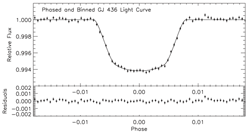EPOXI
Two intriguing investigations -- One flight-proven spacecraft
EPOCh Science
EPOCH Science: EPOCh Searches for an Earth-like Exoplanet
by Drake Deming
(Sep 2010) The EPOCh investigation on the EPOXI mission has reported a deep search for an Earth-sized planet orbiting a nearby red dwarf star. The EPOCh search is one of the first photometric campaigns capable of detecting a nearby extrasolar planet comparable in size to our own Earth (for details, see Ballard et al. 2010, Astrophysical Journal, Vol. 716, p. 1047).
 Click for larger image.
Click for larger image.
Fig. 1: EPOCh data for the transit of the Neptune-sized planet orbiting the red dwarf star GJ436. Using data of this quality, EPOCh was able to attain sensitivity to planets as small as 1.5 Earth radii.
CREDIT: Ballard et al. 2010, Astrophysical Journal, Vol. 716, p. 1047
The star Gliese 436 (denoted GJ436) lies 33 light-years from Earth, and was previously known to host a Neptune-sized planet (GJ436b) transiting the star every 2.6 days. The orbit of that exo-Neptune is also known to be slightly eccentric (non-circular). That eccentricity is believed to be the hallmark of perturbations by an unseen planet (called GJ436c). GJ436c could be as small as our Earth. EPOCh observed the GJ436 system nearly continuously for three weeks, and measured eight transits of GJ436b. Those observations, when phased to the orbit of that Neptune-sized planet, reveal the transit of GJ436b with remarkable clarity (see Figure 1). Such a clear transit signature enabled EPOCh to derive a more precise radius for this exo-Neptune, and also to search for the elusive small planet GJ436c. Even an Earth-sized planet would gravitationally perturb the transit times of the exo-Neptune GJ436b, and thus would show a signature in the EPOCh data. Moreover, GJ436c is expected to have an orbit that is approximately edge-on to our line of sight, and it may itself transit the star. Using a new and powerful data analysis technique, EPOCh was able to attain sensitivity to transiting planets as small as 1.5 Earth radii.
In spite of attaining exquisite sensitivity, EPOCh did not detect the putative planet GJ436c, either by seeing it transit or by detecting perturbations to the transit of GJ436b. That negative result has provided motivation for theorists to consider that GJ436c may not exist. Theorists are re-examining their original conclusion that the orbital eccentricity of GJ436b requires the presence of a second planet. It is possible that tidal forces from the star are not sufficient -- even in the absence of a second planet -- to quickly drive the orbit of GJ436b to a circular state, as had been previously believed. That would obviate the need for GJ436c, but would require the interior structure of GJ436b to be unlike the gaseous planets of our solar system. Meanwhile, the search for a nearby Earth-sized transiting planet goes on. EPOCh investigators are applying their powerful new data analysis technique to data from the Spitzer Space Telescope, that also observed GJ436b (see Ballard et al. 2010, http://arxiv.org/abs/1009.0755). While EPOXI cruises toward a November 2010 encounter with comet Hartley-2, Spitzer will execute an EPOCh-type search of another promising red-dwarf-hosted exoplanet system (GJ1214, 42 light-years distant) to find an Earth-sized planet. That search -- to be conducted in the spring of 2011 -- is targeted to the habitable zone surrounding GJ1214. Using the new analysis technique pioneered by EPOCh, the Spitzer results will be sensitive to habitable planets even smaller than our own Earth.
